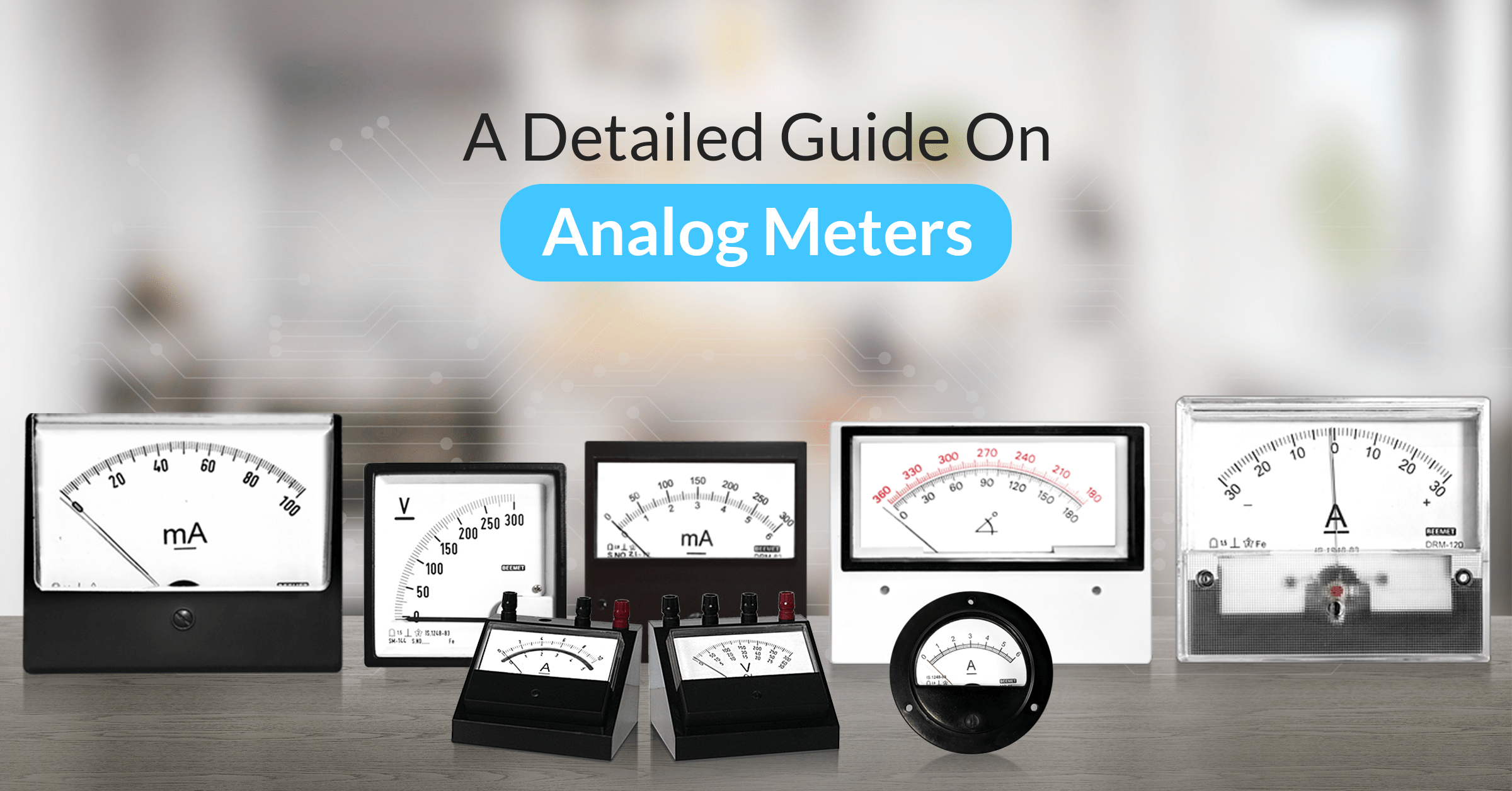An Analog meter is one in which the output is a continuous function of time and has a constant relation to the input. These instruments are used to measure quantities like voltage, current, energy, and power.
An analog meter has a pointer or dial that shows the magnitude of the quantity being measured.
How to Read Analog Meters?
The analog meter has a pointer similar to the hand of a clock. Whenever electricity is used, the pointer moves clockwise or anti-clockwise. The dial of the analog meters has numbers printed on it. The number corresponding to the needle’s final location is the respective value of the quantity being measured.
Here are a few rules to be followed while reading the analog meters:
- If the pointer is between the two numbers, record the lower number. However, there’s an exception. If the pointer is between 0 and 9, that case 9 has to be considered.
- To note the readings clearly, it is advisable to keep the meters dust-free and free of obstruction.
Types of Analog Meters
Analog meters are broadly categorized according to the quantity they measure. An instrument that measures current is classified as an ammeter, and the one that measures voltage is a voltmeter. Similarly, wattmeters and frequency meters are also examples of analog meters.
The analog meters can be categorized into 3 types:
- Indicating Instruments
As the name says, these analog instruments directly indicate the quantity that is being measured. The dial or pointer of the analog meters shows the magnitude of the respective quantity.
Voltmeters and ammeters are examples of analog indicating instruments. These analog indicating instruments can be further divided into 2 groups – Electrochemical instruments and electronic instruments.
- Recording Instrument
These analog instruments give a record of the quantity that is being measured over a specific time period. The variation in the quantity being measured can be recorded on paper. A voltmeter that keeps on recording the variations of the supply voltage throughout the day is an example of analog recording instrument.
- Integrating Instruments
Such instruments measure the summation of the electric quantity over a specified period of time. Ampere-hour and watt-hour meters are examples of these types of instruments.
Analog instruments can also be classified based on the methods used by the instruments for comparing the measured quantity. There are two types of classification –
- Direct Measuring Instruments: These instruments are the most frequently used because of their simplicity and affordability. Direct instruments convert the energy of the measurement into energy that activates the instrument. The value of the unknown quantity is measured or recorded directly. Voltmeter, Wattmeter, and ammeter are direct measuring instruments. You can quickly measure the unknown quantity using direct measuring instruments.
- Comparison Instruments: Comparison instruments measure the unknown quantity by comparing it with a standard value. Whenever a higher accuracy is required, comparison instruments are used. AC and DC bridges are examples of comparison instruments.
Accuracy of Analog Meters
The broad range of accuracy for analog meters is 1-5%.
Principle of Operation of Analog Meters
Here are a few principles of operation of analog meters:
- Magnetic Effect: The current flowing through the coil creates a magnetic field around it. This current flowing through the coil produces the magnetic effect.
- Thermal Effect: The current passing through the heating element increases its temperature. A thermocouple is attached to the element. This thermocouple converts the temperature into the emf. This process of conversion of the current into emf with an increase in temperature is known as the thermal effect.
- Induction Effect: The non-magnetic disc in a magnetic field produces an electromotive force. This electromotive force produces the electric current inside the drum. This induced current and electromotive force move the disc. This effect is induction effect.
- Hall Effect: In the Hall Effect, a conducting material produces an electric current in the presence of the magnetic field. There is also a formation of potential differences across a conducting material. The magnitude of potential difference highly depends on flux density, current and property of the conductor.
Working of Analog Measuring Instruments
An Analog meter is a permanent magnet moving coil (PMMC) instrument. This means when the current is passed through the coil, the coil moves in a magnetic field that is produced by analog meter (permanent magnet). A pointer is attached to the coil. When the current flows through the coil, a deflecting torque acts on the coil that can rotate it by an angle, so the pointer moves over the scale.
To measure direct current, analogue meter acts as an ammeter when connected with low series resistance. For measuring high current, a shunt resistance is connected in parallel with the galvanometer. When the shunt resistance is connected in parallel, the analog meter can measure current in the range of ampere or milli-ampere.
When connected to a multiplier resistor, an analog meter can act as a voltmeter and can measure the DC voltage in kilo-volts or milli-volts.
When connected to a battery and a network of resistors, the analog meter acts as an ohmmeter. You can change the value of shunt resistance in the resistor network to measure the different resistance values.
Applications of Analog Electric Meter
- Used to measure voltage, current, energy, and power
- Used to measure radiofrequency transmissions
- Frequently used to measure 3-phase power
- Used in power control and motor control panels
- Also used in relay and control panels
- Analog panel meters can also measure speed, weight and acceleration.
Advantages of Analog Meters
- Analog meters are easy to read. The pointer or dial can be modified to display special values.
- Analog meters can even operate without external power. If there is a dangerous level of current or voltage present in the circuit, analog meters can alert the users.
- One of the major advantages of analog meters is that they can visually indicate the signal level. Various colour schemes can be used to define normal and dangerous levels. Users can use this colour chart to see if the operation is within normal conditions.
Conclusion
Analog meters can show both single and multiple signals. A pointer or dial shows the values being measured. These devices display the signals directly, with no conversion process. Analog meters are used widely because of their ease of use and range of applications.
Hope you enjoyed reading this blog. If you are interested in electrical instruments, dive into our dedicated blogs on Digital meters, Current Transformers, and DC Shunts.
FAQ
An analog meter is a device that measures physical quantities like voltage, current, energy, or power. It uses a pointer or dial to show the measurement as a continuous function of time.
Analog measuring instruments work by converting the input quantity into a deflection on a pointer or dial. The movement occurs due to principles like magnetic, thermal, or induction effects.
An analog electric meter is used to measure electrical quantities such as voltage, current, power, and energy. It is also used in relay control panels and motor control systems.
Analog meters use a dial or pointer to show readings, while digital meters display readings as numbers on a screen. Analog meters are simpler but less precise compared to digital meters.
Examples of analog instruments include:
- Voltmeters: Measure voltage.
- Ammeters: Measure current.
- Wattmeters: Measure power.
- Frequency Meters: Measure frequency.
Analog meters generally have an accuracy range of 1-5%. They are suitable for applications where extreme precision is not required.
Analog meters are easy to use and don’t require external power. They visually indicate the signal level and can alert users to dangerous voltage or current levels using color-coded scales.



